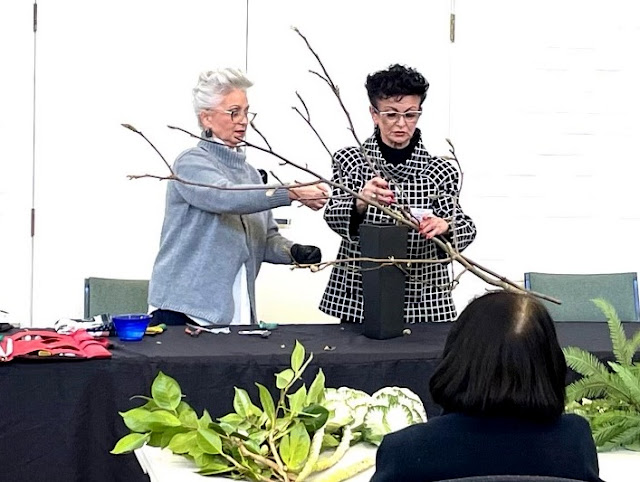Hello all,
For last week's class, for the advanced students, I had set the theme 'Composition Expressing a Movement'. In this exercise it is important to differentiate between a verb and a movement. Although all movements are verbs, the reverse cannot be said. For example words such as sleeping, sitting, standing, thinking are all verbs, but they are not movements. Running, jumping, dancing, throwing, punching are all movements. That's what we are required to express.
My arrangement, above, was done with variegated agave and I'm hoping that the movement of 'walking' is recognisable.
Jenny's arrangement, below, expressed the movement 'Exploding'. She, painstakingly, curled strips of variegated flax leaves and added billy buttons and dianthus in a delightful, glass vase.
Nicole's arrangement expressed 'Fighting'. She used rather aggressive looking aloes with tendrils intertwined in two, matching, ceramic vases.
Cym wanted to express 'Swirling'. She used palm inflorescence and dietes leaves to create the movement. The vase is made of glass.
She, then, placed it on a tall vase and added queen's tears bromeliad flowers, leucadendrons and white lilly pilly berries.
Wendy's curriculum lesson was 'Disassembling and Rearranging the material'. She, very painstakingly, removed all the leaves and berries from cotoneaster branches. She used the branches to create the curved lines and placed the berries in a glass bowl inside a larger, glass vase. The stem of the tulip that she added reflected the curves of the branches and added another element to the arrangement.
Lei's curriculum lesson was 'Green Plant Materials'. She used a large, fatsia leaf, fatsia berries and chocos in a ceramic vase. Although the materials are all green, enough interest is created by the different textures and shapes.
Dianne's lesson was a 'Mass Arrangement'. She created three different groups of massed materials - euphorbia, hypericum berries and alstroemeria psittacina leaves in a newly acquired, ceramic container.
Mary's lesson was 'Arrangements for Celebrations'.Mary chose to celebrate the birthday of a friend who loves Australian natives. She used a wattle, whose name I was not able to find and dwarf banksias in an arrangement based on Variation No. 3, slanting style, nageire.
Bye for now,
Emily





































